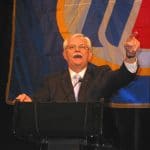WASHINGTON — In a 5-4 decision, the Supreme Court June 23 declined to tighten the standard of proof injured rail workers must demonstrate to win an award under the Federal Employers’ Liability Act (FELA).
The ruling is a significant victory for injured rail workers.
The FELA — a railroader’s most cherished workplace safety assurance — was passed by Congress more than a century ago to make railroads liable if an employee injury or death results “in whole or in part” from the negligence of any of its officers, agents or employees, or from any defect or insufficiency in equipment or roadbed.
At the time of the FELA’s passage in 1908, more than 4,000 railroaders were killed annually, and some 63,000 more suffered serious injuries each year.
The Supreme Court previously held that the FELA was “designed to put on the railroad industry some of the costs of the legs, arms, eyes, and lives which it consumed in its operation.”
The June 23 Supreme Court decision turned on a crossover vote by conservative Justice Clarence Thomas, who joined liberals Ruth Bader Ginsburg, Sandra Sotomayor, Elena Kagan and Stephen Bryer to rule against CSX and in favor of an injured CSX locomotive engineer.
The engineer had won a monetary award from a federal district court after being injured on the job in 2004 while operating a locomotive that the engineer contended was not suited for switching operations.
CSX twice unsuccessfully appealed the trial court’s decision – the first before the 7th Circuit Court of Appeals and the second appeal before the Supreme Court. CSX contended in both unsuccessful appeals that injured rail workers should meet a more demanding standard of proof as is required in all non-FELA personal injury cases, not, as the trial court instructed the jury, that CSX was responsible for negligence if its negligence “played a part – no matter how small – in bringing about the injury.”
CSX sought a ruling that the employer’s action must be the “primary cause” of the injury. In fact, the “in whole or in part” language comes from the FELA itself, and that legislative language clearly impressed the Supreme Court’s majority in this case.
Writing for the majority, Justice Ginsburg said: “Juries in such cases are properly instructed that a defendant railroad ‘caused or contributed to’ a railroad worker’s injury ‘if [the railroad’s] negligence played a part – no matter how small – in bringing about the injury.’ That, indeed, is the test Congress prescribed for proximate causation in FELA cases.”
Earlier Supreme Court cases upheld the right of unions to advise injured workers to obtain expert legal advice, and the right of unions to designate legal counsel possessing specialized knowledge in railroad operations and the FELA.
A listing of UTU Designated Legal Counsel is provided at www.utu.org by moving the cursor to “About UTU” in the red horizontal bar at the top of the home page and then clicking on “Designated Legal Counsel.” A listing of Designated Legal Counsel also may be obtained from local union officers or your general chairpersons.
If you are injured on the job, the FELA and your UTU Designated Legal Counsel are the best friends you and your family have. These successful trial lawyers are specialists in handling FELA claims, and are fully experienced in dealing with railroad claim agents and railroad lawyers.
And remember: Contributory negligence is not a bar to recovering under the FELA; and the FELA prohibits railroads from retaliating against employees who provide Designated Legal Counsel with factual information on injuries to fellow employees, or who testify in support of injured workers.
Each FELA lawsuit sends to the carriers a message about improving workplace safety that they cannot ignore
To read the June 23 Supreme Court decision, CSX Transportation, Inc. v. Robert McBride, click on the following link:
www.supremecourt.gov/opinions/10pdf/10-235.pdf


